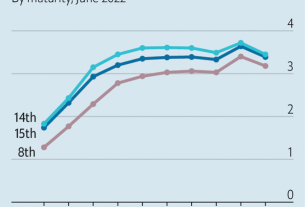
Representative Image
Wall Street slid deeper into a bear market on Monday, with the S&P 500 and Dow closing lower as investors fretted that the Federal Reserve’s aggressive campaign against inflation could throw the U.S. economy into a sharp downturn.
After two weeks of mostly steady losses on the U.S. stock market, the Dow Jones Industrial Average (.DJI) confirmed it has been in a bear market since early January. The S&P 500 index (.SPX) confirmed in June it was in a bear market, and on Monday it ended the session below its mid-June closing low, extending this year’s overall selloff.
With the Fed signaling last Wednesday that high interest rates could last through 2023, the S&P 500 has relinquished the last of its gains made in a summer rally.
“Investors are just throwing in the towel,” said Jake Dollarhide, Chief Executive Officer of Longbow Asset Management in Tulsa, Oklahoma. “It’s the uncertainty about the high-water mark for the Fed funds rate. Is it 4.6%, is it 5%? Is it sometime in 2023?”
Confidence among stock traders was also shaken by dramatic moves in the global foreign exchange market as sterling hit an all-time low on worries that the new British government’s fiscal plan released Friday threatened to stretch the country’s finances.
That added an extra layer of volatility to markets, where investors are worried about a global recession amid decades-high inflation. The CBOE Volatility index (.VIX), hovered near three-month highs.
The Dow is now down 20.5% from its record high close on Jan. 4. According to a widely used definition, ending the session down 20% or more from its record high close confirms the Dow has been in a bear market since hitting its January peak.
The S&P 500 has yet to drop below its intra-day low on June 17. It is down about 23% so far in 2022.
In Monday’s session, the Dow Jones Industrial Average (.DJI) fell 1.11% to end at 29,260.81 points, while the S&P 500 (.SPX) lost 1.03% to 3,655.04.
The Nasdaq Composite (.IXIC) dropped 0.6% to 10,802.92.
Ten of 11 S&P 500s sector indexes fell, led by 2.6% drops in real estate (.SPLRCR) and energy (.SPNY).
Gains in Amazon and Costco Wholesale Corp (COST.O) helped limit losses in the Nasdaq.
Shares of casino operators Wynn Resorts (WYNN.O), Las Vegas Sands Corp (LVS.N) and Melco Resorts & Entertainment jumped between 11.8% and 25.5% after Macau planned to open to mainland Chinese tour groups in November for the first time in almost three years.
Volume on U.S. exchanges was 11.9 billion shares, compared with the 11.2 billion average for the full session over the last 20 trading days.
Declining issues outnumbered advancing ones on the NYSE by a 5.37-to-1 ratio; on Nasdaq, a 2.31-to-1 ratio favored decliners.
The S&P 500 posted no new 52-week highs and 120 new lows; the Nasdaq Composite recorded 16 new highs and 594 new lows.

